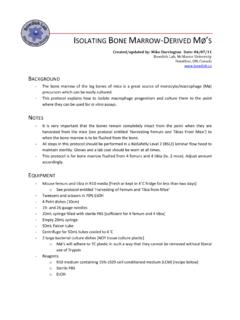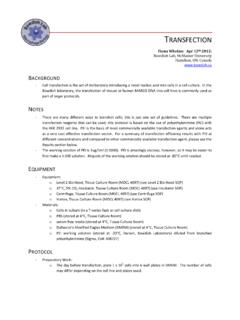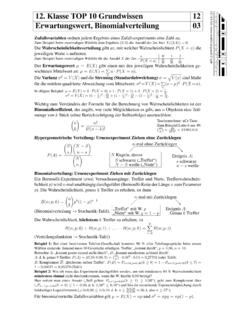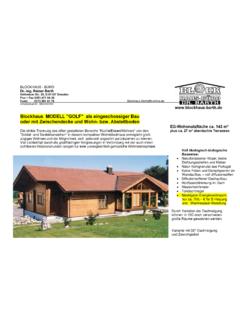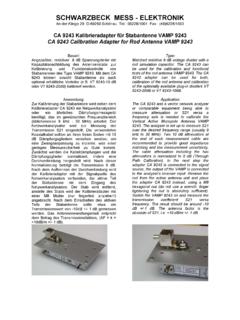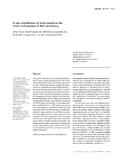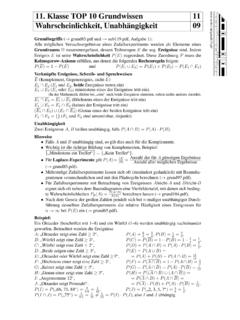Transcription of MAINTENANCE CULTURE OF THP-1 CELLS - Bowdish
1 MAINTENANCE & CULTURE OF THP-1 CELLS Created/updated by: D. Bowdish Date: July, 2011 Bowdish Lab, McMaster University Hamilton, ON, Canada BACKGROUND These CELLS are monocyte-like cell line derived from leukemia from a one year old boy (ATCC#TIB-202) 1). They express complement (C3), Fc receptors and are phagocytic (for both latex beads and sensitized erythrocytes and others) and lack surface and cytoplasmic immunoglobulin. They are weakly responsive to TLR agonists in their undifferentiated state but become more responsive after differentiation. Monocytic differentiation can be induced with the phorbol ester 12-O-tetradecanoylphorbol-13-acetate (TPA)/ phorbol 12-myristate 12-acetate [Sigma P 8139]. This is an insoluble (in water) phorbol ester that must be resuspended at high concentrations in DMSO. Its exact function is not known but it is believed to mimic signalling molecules that are inserted in the inner face of the plasma membrane and stimulate the PKC pathway.
2 Thus, once added it cannot be washed away and differentiation is The doubling time is approximately 26 hrs. NOTES Freezer stocks: These CELLS are more susceptible than most to freeze/thaw damage. They also seem to secrete some sort of growth factor so that if they are very dilute they grow slowly, if they are at a higher concentration they grow faster, thus freezer stocks are made denser than normal. Media: ATTC recommends RPMI 1640 medium with 2 mM L-glutamine adjusted to contain g/L sodium bicarbonate, g/L glucose, 10 mM HEPES and mM sodium pyruvate and supplemented with mM 2-mercaptoethanol, 90%; fetal bovine serum, 10%. (Sodium pyruvate is used by CELLS as an easily accessible carbohydrate source. Additionally, it is involved with amino acid metabolism and initiates the Kreb's cycle.)
3 2-mercaptoethanol is a complete mystery. The theory is that it enhances uptake of cysteine and consequently the MAINTENANCE of intracellular glutathione levels are enhanced, it protects from oxidative damage, enhances antigen presentation & reduces clumping. All the references say that this only occurs in mouse CELLS so I say that it s just superstition). I use: RPMI 1640 medium with 2 mM L-glutamine, 10% FBS. Propagation: These CELLS are happiest at a density of between 1x10E5 CELLS /ml to 1x10E6 CELLS /ml (2x10E6 CELLS /ml maximum). If they get denser then this they will be very unhappy, may slow down or stop dividing and may clump or have an irregular or blebbing appearance. If they start to look like this throw them away & take out a new freezer vial, they won t recover. In theory, one should only use them to 5 passages as their properties might change over time 3.
4 In practice this is not always observed. Differentiation: PMA treatment will induce a terminal differentiation. They will no longer divide, will adhere, metabolise more slowly and take on an appearance that is closer to that of a real macrophage. PROTOCOL To freeze CELLS : Grow to a density of 1 x 10E6 CELLS in 20 mls of media. Centrifuge at 1000rpm x 5 min. Resuspend in mls of FCS and add 400 ul of DMSO in a dropwise manner. Pipette 1mL into a cryovial. Put into a freezing bomb & store at -80 C overnight. Transfer to liquid nitrogen or keep in -80 C for up to 6 months. To defrost CELLS : Warm media (see recipe below) to 37 C. Pipette 30 mls into a 50 ml conical tube and keep warm. Take a vial of frozen CELLS and defrost as quickly as possible ( but swirling in the 37 C water bath) until just defrosted. Pour the contents into the warmed media and centrifuge at 1000 rpm x 5 min.
5 This removes the DMSO. Resuspend in 15 mls media & incubate overnight. Check cell density the next day & adjust accordingly. To CULTURE CELLS : ATCC says: Cultures can be maintained by the addition of fresh medium or replacement of medium. Alternatively, cultures can be established by centrifugation with subsequent resuspension at 2-4 X 10(4) viable CELLS /ml. Subcultutre when cell concentration reaches 8X105) not allow the cell concentration to exceed 1 X 10(6) CELLS /ml. Change media every 2 to 3 days. I say: Start cell cultures at 1x10E5 CELLS /ml in 20mls media, let grow to approximately 1 x 10E6cells/ml by allowing to grow for 3-4 days (roughly 1x10E6). Split 1/5 by centrifuging CELLS , resuspending in 5 mls and adding 1ml to 19mls of media. To Differentiate CELLS : PMA treatment. Centrifuge CELLS and resuspend in fresh media to a concentration of 2x10E5 CELLS per ml.
6 For experiments is a 24 well plate add 1 ml of cell suspension, for 6 well plate, add 5 ml of media. Dilute PMA to 100nM. Allow to differentiate for 3 days( add PMA on Friday, the CELLS will be ready on Monday). If you need to lift the CELLS , you can use trypsin, or a non-enzymatic cell dissociation solution, I have found that trypsin treatment tends to have a higher background for signalling experiments than other methods. LINKS AND REFERENCES 1. Tsuchiya S , et al. Establishment and characterization of a human acute monocytic leukemia cell line ( THP-1 ). Int. J. Cancer 26: 171-176, 1980. PubMed: 6970727 2. ). 3. Cell Oct 10;197(1)

